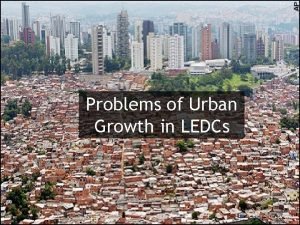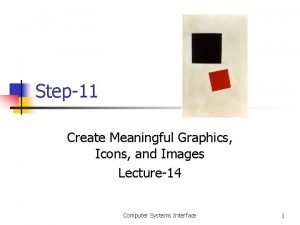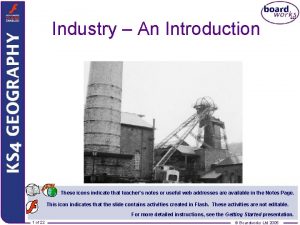Industry in LEDCs These icons indicate that teachers

















- Slides: 17

Industry in LEDCs These icons indicate that teacher’s notes or useful web addresses are available in the Notes Page. This icon indicates that the slide contains activities created in Flash. These activities are not editable. For more detailed instructions, see the Getting Started presentation. 1 of 16 © Boardworks Ltd 2005

Learning objectives Industry in LEDCs What are the formal and informal sectors? Why do transnational corporations locate in LEDCs? What are the advantages and disadvantages for the host country? 2 of 16 © Boardworks Ltd 2005

What are the formal and informal sectors? Most LEDC cities have grown rapidly and the number of people is often far greater than the jobs that are available. People therefore have to find work for themselves. This is called the informal sector of employment. 3 of 16 The formal sector is controlled by the government and large companies. © Boardworks Ltd 2005

Formal and informal employment 4 of 16 © Boardworks Ltd 2005

Formal and informal employment 5 of 16 © Boardworks Ltd 2005

Examination question In LEDCs many people work in the informal sector. What is the informal sector? From the list below tick two jobs that belong to the informal sector: Shop assistant Shoeshiner Police officer Fruit vendor Worker in a bottle factory 6 of 16 © Boardworks Ltd 2005

Learning objectives Industry in LEDCs What are the formal and informal sectors? What is a TNC? Why do transnational corporations locate in LEDCs? What are the advantages and disadvantages for the host country? 7 of 16 © Boardworks Ltd 2005

Transnational corporations in LEDCs 1. A TNC has factories and offices in several countries. Therefore it is a global company in that it operates across national boundaries. The HQ of a TNC is usually in an MEDC with the factories worldwide. 2. Transnational companies have the power to choose where to locate their factories. They are attracted to LEDCs due to - 1. Large pool of cheap labour, 2. Low wages/long working hours 3. Lower taxes 4. Fewer rules on health and safety and workers rights 5. Not allowed to go on strike! 8 of 16 © Boardworks Ltd 2005

Learning objectives Industry in LEDCs What are the formal and informal sectors? Why do transnational corporations locate in LEDCs? What are the advantages and disadvantages for the host country? 9 of 16 © Boardworks Ltd 2005

Effects of TNCs in LEDCs: good or bad? 10 of 16 © Boardworks Ltd 2005

Effects of TNCs in LEDCs Now summarize the positives and the negatives. 11 of 16 © Boardworks Ltd 2005

Fair Olympics Campaign 12 of 16 © Boardworks Ltd 2005

Do TNCs benefit the environment? Use the information here and your own research to decide whether TNCs benefit the environment. © Boardworks Ltd 2005 13 of 16

Change in manufacturing location Manufacturing is growing in some countries and declining in others. 14 of 16 © Boardworks Ltd 2005

Examination question continent salt silver borate uranium Study the map showing some of Rio Tinto’s mines. Complete the table. Why is this company described as a transnational company (TNC)? Use examples to examine the advantages and disadvantages that TNCs bring to LEDCs. 15 of 16 © Boardworks Ltd 2005

Industry in LEDCs quiz 16 of 16 © Boardworks Ltd 2005

Key ideas Industry in LEDCs The informal sector of employment is created by people finding work for themselves. This is usually due to the rapid growth of LEDC cities. Some examples of jobs are scrap collectors, street entertainers and shoeshiners. The formal sector of employment is controlled by the government and large companies. Some examples of formal jobs are factory workers, shop assistants and nurses. A transnational company (TNC) is a global company in that it operates across national boundaries. They are attracted to the large pool of labour, low wages, taxes and fewer restrictions of LEDCs. TNCs bring economic, social and environmental advantages and disadvantages to the host countries. 17 of 16 © Boardworks Ltd 2005
 Urbanisation in ledcs
Urbanisation in ledcs Ledcs in africa
Ledcs in africa Alphabet of lines drawing
Alphabet of lines drawing Walmart thất bại ở nhật
Walmart thất bại ở nhật Gây tê cơ vuông thắt lưng
Gây tê cơ vuông thắt lưng Block xoang nhĩ
Block xoang nhĩ Tìm vết của mặt phẳng
Tìm vết của mặt phẳng Sau thất bại ở hồ điển triệt
Sau thất bại ở hồ điển triệt Thơ thất ngôn tứ tuyệt đường luật
Thơ thất ngôn tứ tuyệt đường luật Con hãy đưa tay khi thấy người vấp ngã
Con hãy đưa tay khi thấy người vấp ngã Thơ thất ngôn tứ tuyệt đường luật
Thơ thất ngôn tứ tuyệt đường luật Tôn thất thuyết là ai
Tôn thất thuyết là ai Phân độ lown
Phân độ lown Kim kroll
Kim kroll Meaningful graphics
Meaningful graphics Mario casas icons
Mario casas icons Value matrix
Value matrix Aim dollz icons
Aim dollz icons

































